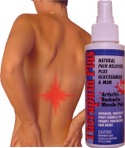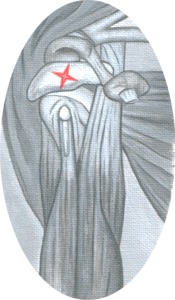Sponsored by
Relief-Mart
Are you suffering
from Bursitis?

Click
here to learn about how Therapain Plus With MSM
and Glucosamine can help!
Site Navigation:
Home
About Us
Email
Us
Advertisement Policy
Newsletter
Privacy Statement
Reader Survey
|
Bursitis.org
Quick tip: stop the friction between tendon, bursa, and bone by simply resting the inflamed area with more short frequent restful breaks to allow the natural lubrication of the bursa to reactivate between uses. |

Dr. Rick Swartzburg,D.C.
Author of
1backpain.com, tendonitis.net,
probiotic.org
and
memoryfoammattress.org
Looking for more
information on the latest Bursitis
treatments, clinical studies and research?
Sign Up for your free
Bursitis.org Newsletter Below:
 Bursitis.org
Bursitis.org
Bursitis information and
treatment options
Advertisement:
How Bursitis Occurs
The bursa is what cushions the tendon and thereby helps prevent friction between the tendon and the bone. Unfortunately, constant rubbing of the tendon over the bone with high amounts of repetitive arm, shoulder, hip, knee and ankle motion can lead to enough friction of the bursa itself to cause the inflammation and irritation of the bursa called bursitis. For example, a person who throws a ball too many times at one interval may begin to cause this friction process in the shoulder or elbow. Another way that bursitis occurs is when compression of the bursa happens on a regular basis, such as a side sleeper who places a lot of shoulder or hip pressure when they lay down for long periods. In this case it would not take too much movement of this already compressed area to cause friction of the bursa.
Common Areas of Bursa inflammation
The most common tendon areas that become inflamed are the elbow, shoulder, hip, knee, ankle, and heel. Of course, bursitis can will vary with each person, as it strikes the areas you use and irritate the most.
Bursitis Symptoms
Symptoms can vary from an achy pain and stiffness to the local area of the joint, to a burning that surrounds the whole joint around the inflamed bursa. With this condition, the pain is usually worse during and after activity, and the bursa and surrounding joint area can become stiffer the following day.
Bursitis Treatment
With proper care for the area, the pain in the bursa should lessen over three weeks, but it should be noted that the healing of the area continues and doesn't even peak until at least six weeks following the initial injury. This is due to scar tissue formation, which initially acts like the glue to bond the tissue back together. Scar tissue will continue to form past six weeks in some cases and as long as a year in severe cases. After 6 months this condition is considered chronic and much more difficult to treat. The initial approach to treating a bursitis is to support and protect the bursa by bracing any areas of the tendon that are being pulled on during use, as this will help stop bursa friction from occurring. It is important to loosen up the tendons, lessen the pain, minimize any bursa inflammation, and reduce the compression that can occur with lying down or sitting.
The pressure can be reduced while sleeping by using a softer bed topper like a memory foam mattress pad or even getting a new mattress that is composed with memory foam and/or latex foam. Memory foam and latex foam reduce compression because they are the only substances that conform with the bumps and curves of the body and can thereby reduce the pressure spot by more evenly disbursing the weight of the body. See memoryfoammattress.org for information on this subject. Reducing bursa inflammation and soothing the pain of bursitis can be done topically if a pain reliever has the ability to penetrate the skin barrier and contains anti-inflammatory agents. A topical formula that contains natural menthol will not only relieve pain, but dilate the blood vessels. This allows for relief of the bursitis, without causing any stiffening of the tissue. MSM, also known as Methyl Sulfonyl Methane is a natural supplement that is getting a lot of attention due to its role in tissue healing at a cellular level. It is a natural organic sulfur that comes from rain fall and is found naturally in the human body. It has been shown to have anti-inflammatory effects on the tissues. See all about Glucosamine and MSM for more information this supplement. Ice can relieve inflammation, but will constrict the blood vessels and further stiffen the joint area. Cortisone injections can reduce inflammation, but unfortunately are very caustic and can cause a weakening of the tissue structure and a create more scar tissue. Dr. Swartzburg, our site editor, worked in conjunction with our sponsor, Relief-Mart, to develop a spray for Bursitis called Therapain Plus. It has all natural pain relievers plus 14,000mg of MSM and Glucosamine.
After the scar tissue has begun to accumulate, it will be important to perform procedures which help break down the scar tissue in the affected joint, so as to let the tendon, bursa and muscle regain it's normal flexibility and thereby lessen the friction to the bursa with joint movement. This will also help reduce the chance of further injury. While exercise is appropriate for breaking down scar tissue once the area has healed, it may further irritate the area during the initial stages. Therefore, other methods that can be performed by your healthcare provider, such as ultrasound and massage, may be safely used to accomplish this early on in the injury. Ultrasound uses sound waves that vibrate a such a fast level, that it cannot be felt with normal use. Ultrasound will cause an increase in circulation to the tissue and soften the scar tissue to allow it to further break down. Ultrasound can also be used as phonophoresis to help topical pain and nutrient solutions reach further down into the tissues by transporting them with the sound waves. Light stretches of the affected joint at this stage may also be performed if they do not cause any further irritation to the area, however, often the real key is stretching the tight muscles and tendons that are below or above the bursa, as this will help normalize the movement and stop the rubbing of the tendon on the bursa sac.
Bursitis Prevention
Prevention of this condition requires routine stretching the affected joint, as well as any tightened muscles above and below on a regular basis and thereby lengthening the tendon connections around the bursa. This will allow less friction to the tendon/bursa/bone connection. As mentioned previously, reducing the compression with sitting or lying down is crucial for helping to keep the bursa from losing its natural lubrication and allowing the bursa friction to occur more readily. When bursitis does occur, it is important to treat it immediately, and thereby prevent it from reaching a stage that is more severe.
*For the recommended Bursitis
treatment spray plus MSM and Glucosamine from our sponsor
Relief-Mart,
click here.